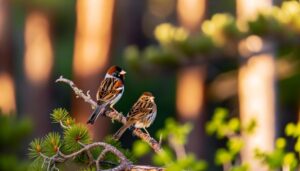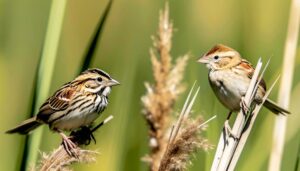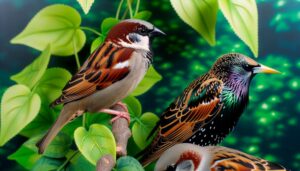3 Key Differences Between House vs Song Sparrows
House Sparrows have stout bodies, short tails, and conical bills with brown and gray plumage, thriving in urban environments. Song Sparrows feature intricate streak patterns, longer tails, and delicate bills, preferring wetlands and shrubby areas.
While House Sparrows mainly eat seeds, Song Sparrows shift to insects during breeding seasons. Their vocalizations differ; House Sparrows' are simpler, whereas Song Sparrows' songs are complex.
House Sparrows build urban nests, forming cohesive flocks, while Song Sparrows favor vegetative nests and more solitary behavior. Migration patterns also vary, with Song Sparrows showing partial migration.
Explore deeper into their ecological niches and conservation challenges.
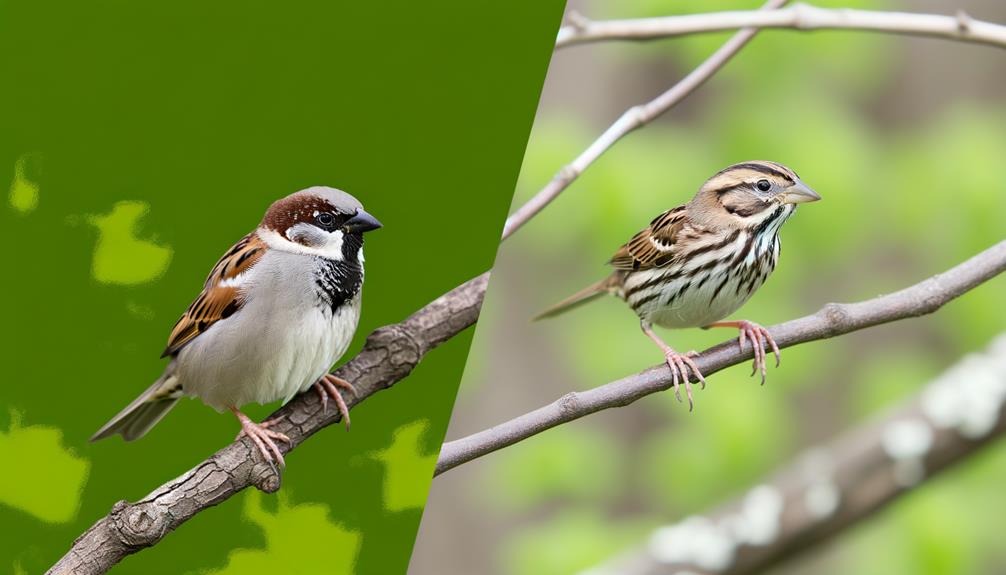
Key Takeaways
- House Sparrows prefer urban areas, while Song Sparrows thrive in wetlands, grasslands, and shrubby areas.
- House Sparrows have a stout body and short tail; Song Sparrows have a streaked chest and longer tail.
- House Sparrows primarily eat seeds, whereas Song Sparrows shift to insects during breeding seasons.
- House Sparrows exhibit simpler vocalizations; Song Sparrows produce complex, melodious songs.
- House Sparrows are highly social and form flocks; Song Sparrows are more solitary and territorial.
Physical Characteristics
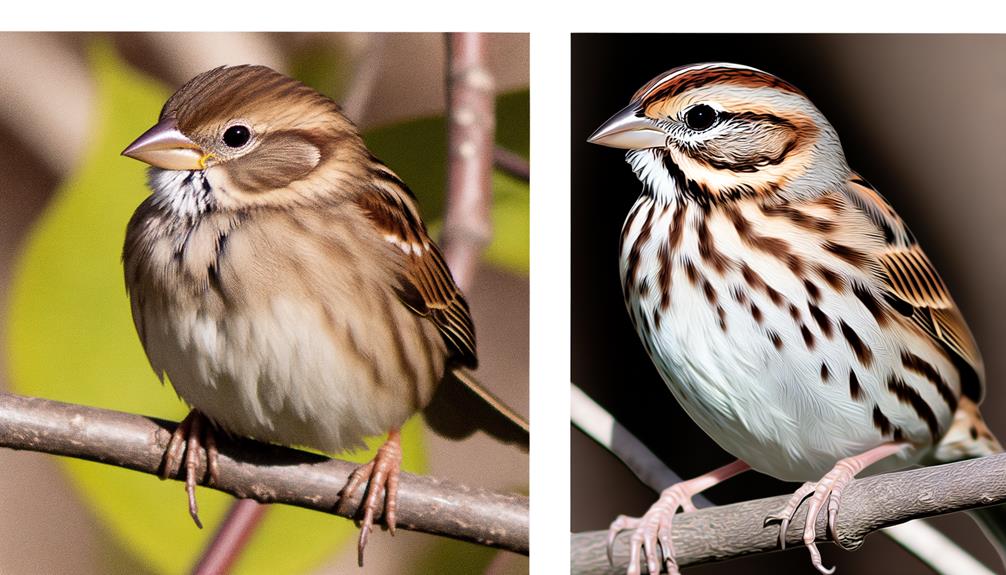
The House Sparrow and the Song Sparrow exhibit distinct physical characteristics, with the former showcasing a stout body and short tail, while the latter is recognized by its streaked chest and longer tail.
House Sparrows, or Passer domesticus, display a robust form with a conical bill adapted for seed consumption. Their plumage includes shades of brown and gray, featuring a black bib in males.
In contrast, Song Sparrows, Melospiza melodia, are characterized by their intricate streak patterns across their chests and a more elongated tail, aiding in their agile flight. Their smaller, more delicate bill suits their varied diet, including insects and seeds.
These differences underscore each species' unique adaptations, reflecting evolutionary paths shaped by their respective ecological niches.
Habitat Preferences
House Sparrows often thrive in urban environments, exploiting human-made structures for nesting, while Song Sparrows prefer more natural habitats like wetlands, grasslands, and shrubby areas.
House Sparrows exhibit synanthropic behavior, integrating closely with human activities and structures, such as buildings and streetlights. Their adaptability to anthropogenic environments contrasts with the Song Sparrows' affinity for areas rich in vegetation and water sources.
Song Sparrows utilize dense foliage for cover and nesting, indicating a preference for ecosystems with greater biodiversity. This divergence in habitat preference highlights their ecological niches: House Sparrows capitalize on urban resources, while Song Sparrows rely on natural, undisturbed settings.
Both species demonstrate remarkable adaptability, yet their chosen habitats underscore distinct evolutionary strategies.
Diet and Feeding Habits
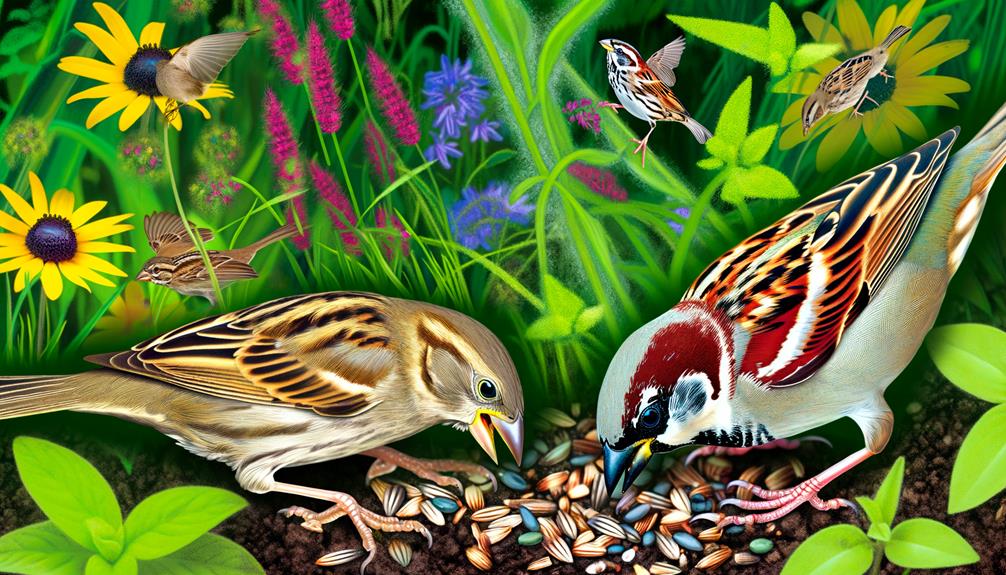
House sparrows and song sparrows exhibit distinct dietary preferences and seasonal feeding habits.
While house sparrows primarily consume seeds, song sparrows exhibit a broader diet by incorporating a significant amount of insects during breeding seasons.
This seasonal dietary shift in song sparrows underscores their adaptive foraging strategies compared to the more consistent seed consumption in house sparrows.
Seeds and Insects Preference
Examining the dietary habits of house sparrows and song sparrows reveals distinct preferences for seeds and insects, highlighting their adaptive strategies for survival.
House sparrows (Passer domesticus) display a pronounced predilection for seeds, particularly from cultivated grains and weed species. This granivorous inclination supports their thriving presence in urban and agricultural settings.
Conversely, song sparrows (Melospiza melodia) exhibit a more varied diet, integrating significant insect consumption alongside seeds. This omnivorous tendency enables song sparrows to exploit diverse habitats, from marshes to meadows. Significantly, their foraging behavior underscores their ecological versatility, capturing insects like caterpillars and beetles to supplement their diet.
These dietary distinctions underscore the sparrows' evolutionary adaptations, reflecting their unique ecological niches and survival strategies.
Seasonal Dietary Changes
Throughout the year, both house sparrows and song sparrows exhibit notable shifts in their dietary habits in response to the seasonal availability of food resources. These changes are driven by:
- Spring: Both species increase their intake of insects to meet the high protein demands for breeding and rearing young.
- Summer: They continue to consume insects but also diversify with fruits and seeds as they become abundant.
- Autumn: Their diet shifts primarily to seeds, preparing for winter scarcity.
- Winter: House sparrows rely heavily on human-provided food sources, while song sparrows forage for remaining seeds and berries.
House sparrows show greater flexibility in adapting to urban environments, utilizing anthropogenic food sources, whereas song sparrows remain more dependent on natural habitats.
Vocalizations
In comparing the vocalizations of the House Sparrow and Song Sparrow, researchers note distinct differences in song patterns, calls, and communication methods.
The Song Sparrow exhibits more complex and melodious song structures, while the House Sparrow's vocalizations are typically simpler and more repetitive.
Both species show seasonal variations in their vocal activity, with changes influenced by breeding cycles and environmental factors.
Song Patterns Comparison
The vocalizations of the House Sparrow and Song Sparrow exhibit distinct song patterns, characterized by differences in pitch, rhythm, and complexity.
The House Sparrow's song is typically a series of monotonous chirps, lacking variation. In contrast, the Song Sparrow's song is melodious and intricate, featuring diverse note sequences.
Key distinctions include:
- Pitch: The House Sparrow's pitch remains relatively constant, while the Song Sparrow's pitch varies significantly.
- Rhythm: House Sparrows maintain a steady rhythm, whereas Song Sparrows demonstrate fluctuating tempos.
- Complexity: Song Sparrows produce more intricate patterns, incorporating trills and buzzes.
- Repetition: House Sparrows favor repetitive sequences, unlike the Song Sparrow's varied repertoire.
These differences highlight the unique adaptations each species has developed for communication.
Calls and Communication
While song patterns provide a glimpse into their intricate vocalizations, House Sparrows and Song Sparrows also use a variety of calls for communication, each serving specific functions such as signaling alarm, coordinating flock movements, or establishing territory.
House Sparrows frequently emit short, repetitive chirps, characterized by a harsh, metallic quality. These calls often facilitate social cohesion within dense urban populations.
In contrast, Song Sparrows utilize a broader range of calls, including sharp ‘chip' notes for alarm and softer ‘tseep' calls for contact. Their calls display more frequency modulation, aiding in nuanced communication across varied habitats.
Both species exhibit call plasticity, adjusting their vocalizations to environmental contexts, enhancing their survival and reproductive success in dynamic ecosystems.
Seasonal Vocal Changes
Both House Sparrows and Song Sparrows exhibit remarkable seasonal vocal changes, adapting their song patterns and call frequencies to align with breeding cycles and environmental shifts. During spring, their vocalizations become more frequent and complex to attract mates and establish territories.
Detailed observations reveal:
- Mating calls: Intensify in complexity and frequency.
- Territorial songs: Increase to ward off intruders.
- Environmental cues: Trigger shifts in call patterns.
- Hormonal changes: Influence vocal intensity and pitch.
Comparatively, Song Sparrows display more intricate song variations than House Sparrows, reflecting their need for precise communication in dense habitats. Conversely, House Sparrows' simpler calls are optimized for urban environments.
These seasonal changes underscore each species' adaptive strategies to maximize reproductive success and survival.
Breeding and Nesting
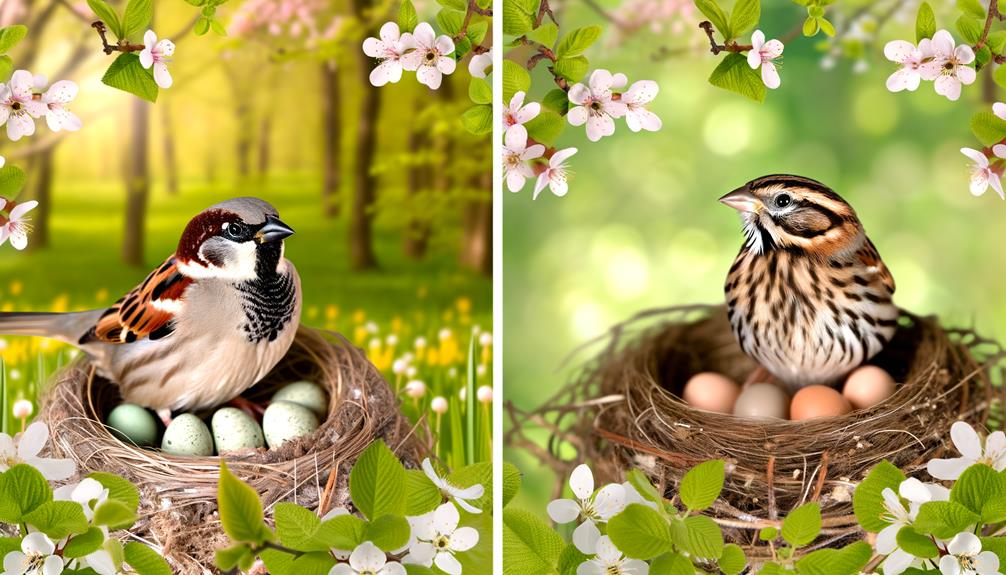
In contrasting their breeding and nesting habits, one observes that House Sparrows often favor urban environments for their nests, while Song Sparrows typically select more secluded, vegetative areas.
House Sparrows build their nests in crevices of buildings, using materials like grass, feathers, and paper. Their urban preference showcases their adaptability to human presence.
Song Sparrows, however, create cup-shaped nests near the ground or in shrubs, utilizing grasses and leaves, reflecting their need for camouflage and protection from predators.
Both species exhibit monogamous breeding, but House Sparrows tend to have multiple broods per season due to abundant resources in cities. Meanwhile, Song Sparrows produce fewer broods, focusing on quality over quantity, given their more resource-limited habitats.
Social Behavior
Their distinct nesting preferences mirror the contrasting social behaviors of House Sparrows and Song Sparrows, revealing unique adaptations to their respective environments.
House Sparrows exhibit highly social behaviors, often forming large flocks. In contrast, Song Sparrows tend to be more solitary or form loose associations with others.
These behavioral differences can be summarized as follows:
- House Sparrows: Highly territorial, form cohesive flocks, engage in communal roosting, and exhibit strong social hierarchies.
- Song Sparrows: Territorial but less aggressive, prefer solitary nesting, engage in individualistic behavior, and display minimal flocking tendencies.
These contrasting behaviors highlight their adaptive strategies for survival, with House Sparrows thriving in urban settings and Song Sparrows adapting well to more natural, less crowded habitats.
Migration Patterns

Unlike the sedentary House Sparrows, Song Sparrows exhibit partial migration, where some populations undertake seasonal movements in response to climatic changes. Northern Song Sparrow populations travel southward to escape harsh winters, whereas southern populations remain year-round. This migratory behavior is known as facultative migration, influenced by environmental factors rather than a fixed schedule.
In contrast, House Sparrows, with their non-migratory nature, adapt to varying climates by exploiting urban and suburban habitats. Their sedentary lifestyle is a proof of their adaptability and resourcefulness.
Researchers note that the Song Sparrow's migration patterns can greatly affect their breeding cycles, habitat selection, and survival rates. Understanding these differences offers insights into each species' evolutionary strategies and ecological niches.
Conservation Status
Despite their widespread presence, both House Sparrows and Song Sparrows face distinct challenges regarding their conservation status. House Sparrows, classified as 'Least Concern' by the IUCN, have seen significant population declines in urban areas due to habitat loss, food scarcity, and pollution.
Conversely, Song Sparrows, also labeled 'Least Concern,' maintain stable populations but encounter localized threats from habitat fragmentation and agricultural practices.
Key conservation challenges include:
- Habitat Loss: Urbanization and deforestation reduce nesting sites.
- Pollution: Pesticides and pollutants impact food sources.
- Climate Change: Alters habitats and food availability.
- Predation: Increased predation from domestic animals and invasive species.
Addressing these challenges requires targeted conservation strategies to guarantee the survival and thriving of both species in their natural habitats.
Conclusion
In the grand avian soap opera, the House Sparrow and Song Sparrow vie for the audience's affection.
The House Sparrow, with its cosmopolitan airs, dines on city scraps, while the Song Sparrow serenades the rural romantics.
One flaunts a boxy nest in urban sprawl; the other crafts a bucolic bowl.
Yet, both face the same critics: habitat loss and climate change.
Ah, Darwin would chuckle—nature's reality show, where survival's the ultimate prize, and adaptation the plot twist.

